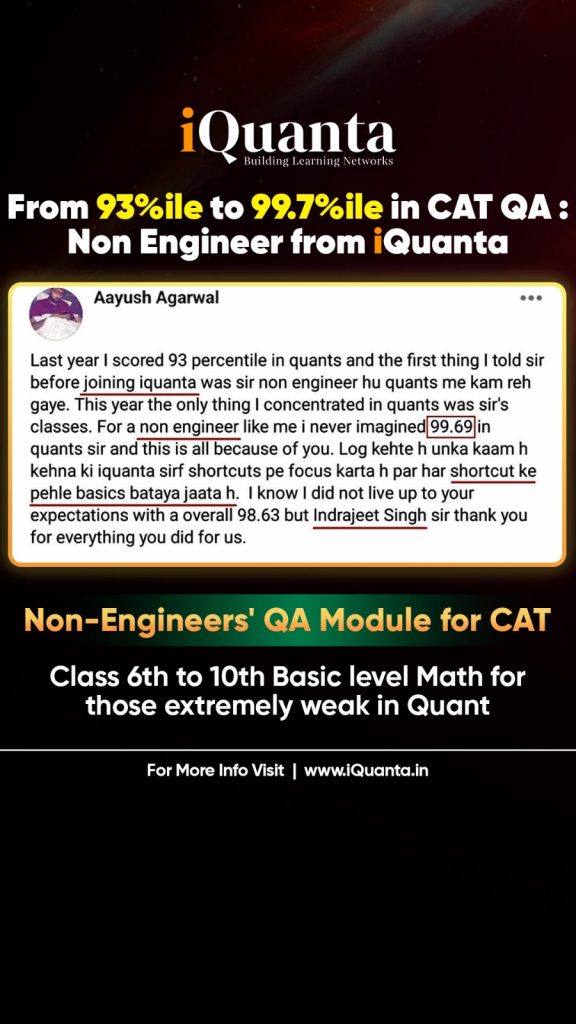The Quantitative Aptitude section of the CAT exam is the most challenging for achieving a high percentile. While it favors engineers, it poses a significant challenge for non-engineers. This section often features the toughest questions, making accuracy crucial. Even with just eight correct attempts, a 95+ percentile is achievable.
The syllabus for Quants has remained largely unchanged over the years. However, recent trends indicate a higher weightage for Algebra and Geometry, along with an increased difficulty level in Arithmetic. This shift has led to considerable confusion among aspirants. In this blog, we will break down trends from previous CAT papers, explore the most common Quants questions, analyze the number and difficulty of Quants questions, and share effective strategies to help you master this section.

Quants 5-Year Trend Analysis
In the past few years, the Quants section of the CAT exam has evolved into a new league of challenges. While the syllabus remains the same which comprises Arithematic, Algebra, Geometry, Modern Maths, and Number Systems. Everything changed after the pandemic of 2020.
| Year | Number of Questions | Difficulty Level | Changes in the section |
| 2020 | 26 | Moderate | Reduction in total questions due to pandemic adjustments. |
| 2021 | 24 | Moderate to Difficult | – |
| 2022 | 22 | Moderate | More weightage to Algebra |
| 2023 | 22 | Difficult | Increase in Question Complexity |
| 2024 | 22 | Moderate to Difficult | Repeated PYQ and more weightage to Geometry |
The CAT Quantitative Aptitude section has evolved despite maintaining 22 questions since 2022. The number of easy questions has declined, with more moderate to difficult, application-based problems appearing. Algebra and Geometry now hold greater weight, while Arithmetic has grown more complex. This shift emphasizes conceptual clarity and problem-solving over quick, pattern-based approaches, making accuracy and deeper understanding essential for scoring well.

CAT Quants Syllabus Breakdown
| Topic | Number of Questions in the last 5 years | Trend Summary |
| Arithmetic | 2020: 8-10 2021:9 2022:8-10 2023:8 2024:8 | The number of Arithmetic questions remains the same, but the difficulty has increased. The focus has shifted to calculation-heavy and concept-based applications, making Arithmetic more challenging. |
| Algebra | 2020:6-7 2021:7-8 2022:7 2023:6-7 2024:9 | More variable-based questions have been introduced, requiring students to think beyond the basics. The use of concise language also makes Algebra questions harder to interpret. |
| Geometry | 2020:3 2021:4 2022:3 2023:4-5 2024:4-5 | Geometry, a vast topic, is appearing more frequently in the exam. Questions now extend beyond just Mensuration and Triangles, requiring students to cover a broader range of concepts. |
| Number Systems | 2020:1-3 2021:1-2 2022:3 2023:1-2 2024:1-2 | CAT 2024 Number System questions were easy, but their real-life context made it harder to determine the appropriate concept to apply. |
| Modern Maths | 2020:1-2 2021:1 2022:1-2 2023:1-2 2024:1-2 | Even though the number of questions remains low, easy to moderate questions are appearing, giving aspirants a better scoring opportunity. |
Join the Largest CAT Preparation Community in India

Hidden Changes in the CAT Quants Exam Pattern
1. Increase in Variable-Based Questions
Previously, when numerical values were provided in Arithmetic or Algebra questions, aspirants could solve them easily. Now, more questions require students to assume variables and determine a range of possible answers, making problem-solving more complex.
2. Reduction in Assumption-Based Shortcuts:
Earlier, Arithmetic questions could often be solved by assuming convenient base values like 100 or simple integers. However, examiners have adapted by designing questions where assumptions don’t work. Answer choices now include irregular numbers like 29,887 or 8,777 instead of round figures, preventing reliance on shortcuts.
3. Longer Calculations Required:
While some easy questions still appear, the process of arriving at the answer has become more time-consuming. Even straightforward problems now involve lengthy calculations, increasing the risk of silly mistakes.
4. Introduction of Trap Questions:
Examiners have recognized how students identify difficult questions and now use misleading numerical values in the given data. These questions appear solvable at first glance but require extensive effort, making them both time-consuming and challenging.
How iQuanta can help you overcome your fear of Quants?
CAT Quants can be daunting, especially with evolving question patterns and hidden traps. iQuanta provides a structured and effective approach to help aspirants tackle these challenges with confidence.
1. Top-Quality Faculty: Learn from experienced mentors who specialize in CAT Quant and understand the latest trends in the exam. Their guidance ensures conceptual clarity and strategic problem-solving techniques.
2. Instant & 24/7 Doubt Solving: Unlike traditional coaching, iQuanta offers real-time doubt resolution, ensuring you don’t waste time stuck on a concept. With 24/7 support, you can ask queries anytime and get immediate solutions.
3. Exclusive New-Pattern Questions & Resources: Stay ahead with access to the latest question trends, including variable-based problems, complex calculations, and trap questions designed to match CAT’s evolving difficulty.
4. Application-Based Classes: Focus on conceptual application rather than rote learning. These sessions help you tackle tricky problems that require deeper analytical skills.
5. Customized Plans for Non-Engineers: iQuanta offers tailored learning strategies to help non-engineers strengthen their Quant fundamentals, ensuring they compete on equal footing with engineering students. The quants module is especially designed for those who have lost touch with Maths and the syllabus is in alignment with the NCERT syllabus of class 6 to 10.

Enroll for iQuanta CAT 2025 Course


